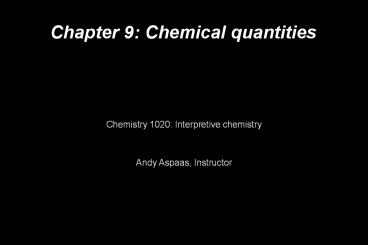Chapter 9: Chemical quantities - PowerPoint PPT Presentation
Title:
Chapter 9: Chemical quantities
Description:
Mass calculations ... Percent yield. All calculations so far have given theoretical yields of products ... Percent yield: measure of experimental efficiency ... – PowerPoint PPT presentation
Number of Views:39
Avg rating:3.0/5.0
Title: Chapter 9: Chemical quantities
1
Chapter 9 Chemical quantities
Chemistry 1020 Interpretive chemistry Andy
Aspaas, Instructor
2
Interpreting chemical equations
- The coefficients in a chemical equation indicate
relative numbers of molecules involved in the
equation - 2H2(g) O2(g) ? 2H2O(g)
- This equation can be interpreted many ways
- 2 molecules H2 gas react with 1 molecule O2 gas
to form 2 molecules H2O gas - 2 dozen molecules H2 gas react with 1 dozen
molecules O2 gas to form 2 dozen molecules H2O
gas - 2 mol H2 gas react with 1 mol O2 gas to form 2
mol H2O gas
3
Mole-mole relationships in reactions
- 2H2(g) O2(g) ? 2H2O(g)
- If you want to produce 15.7 mol H2O, how many
moles of O2 gas are required in this reaction? - Use the coefficients in the balanced chemical
reaction to convert between moles of any
components in a reaction - Mole ratio 1 mol O2(g) for every 2 mol H2O(g)
from the equation - Use that mole ratio as a dimensional analysis
conversion factor
4
Mass calculations
- In chemistry, number of moles is the only unit
that can be used to convert between quantities of
constituents in a chemical reaction - Stoichiometry conversion of masses of different
reactants and products in a chemical reaction - If youre given the mass of a reactant or
product, you must first convert mass to moles - If youre looking to find the mass of a reactant
or product, you must first find the moles, and
then convert to mass
5
Practice mass calculation problems
- CO(g) 2H2(g) ? CH3OH(l)
- What masses of carbon monoxide gas and hydrogen
gas are required to produce 6.0 kg of methanol? - LiOH(s) CO2(g) ? Li2CO3(s) H2O(l)
- What mass of CO2 gas can 1.00 kg of lithium
hydroxide react with?
6
Limiting reagent
- Whenever you are given quantities of more than
one reactant, you must decide which will be
consumed first (the limiting reactant) - The cheese sandwich analogy
- Decide quantity of products that each individual
reactant is able to produce - The reactant that produces the smallest quantity
of product is the limiting reactant
7
Limiting reactant
- Convert each reactant to moles
- Use mole ratios to convert each to moles of
product - Reactant which produces smallest value of product
moles is limiting reactant - Use limiting reactant to calculate product moles
and finally product mass
8
Limiting reactant practice
- N2(g) 3H2(g) ? 2NH3(g)
- Say 25.0 g nitrogen gas and 5 g hydrogen gas are
reacted to form ammonia. What mass of ammonia can
be produced? - Convert reactants to moles
- Convert each to moles products
- Identify limiting reagent
- Product moles from limiting reagent
- Convert to mass of product
9
Percent yield
- All calculations so far have given theoretical
yields of products - The maximum amount of product that can be formed,
assuming all of the limiting reagent reacts, and
all product can be collected - In reality, actual yield is almost always lower
- Percent yield measure of experimental efficiency
- (actual yield) / (theoretical yield) x 100































